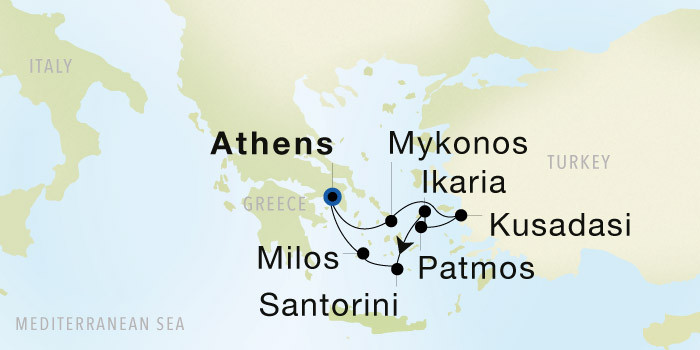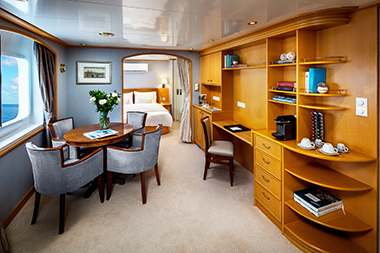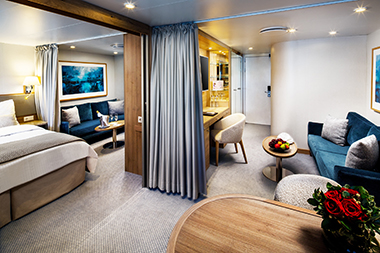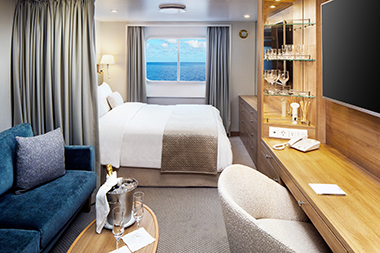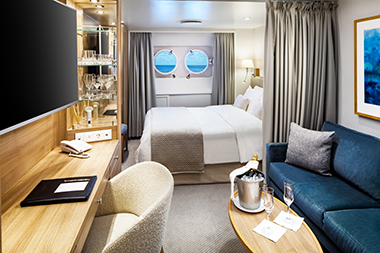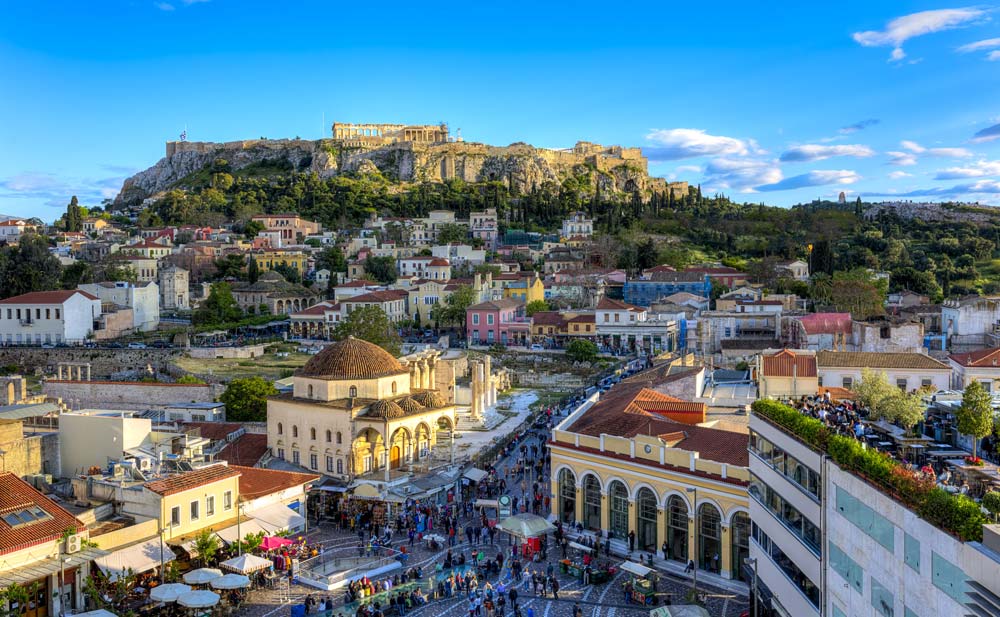
Piraeus, roughly translating to “the place over the passage”, is an important Greek port located within the Athens agglomeration, in the Attica Basin. It is 12 kilometers from the municipality of Athens, considered the fourth largest and is the third most populous amongst all the municipalities of Greece. Now a peninsula, Piraeus, originally a rocky island, was developed in early 5th Century B.C. when it was initially designated as Athens’ import and transit trade port. It is the largest marine-based shipping center of Greece, one of the largest ports in Europe, and considered the second largest passenger port in the world. Inhabited since the 26th Century, it wasn’t until the 6th Century B.C. that Piraeus began catching attention. The land of Piraeus was essentially impassable, flooded by the sea most of the year until centuries passed and the flooding ceased. By the 5th Century B.C. it became a navy base for the Athenian fleet for the natural harbors and the strategic potential they carried. Athenian general and politician Themistocles fortified Piraeus’ three harbors Kantharos, Zea and Munichia, created ship houses and completed his walls in 471 B.C., which led to the port becoming a great military and commercial harbor. There are many archaeological sites, points of interest and entertainment available in Piraeus. Most famous for its tavernas and cuisine, several popular events take place in Piraeus, such as the Ecocinema International Film Festival, the Maritime Festival, the Piraeus Rock Wave Festival and the Three Kings’ Way Festival. There are also many theaters, including the Municipal Theater, the open air Veakeio Theater, and the Menandreio Theater. Museums in Piraeus include the Archaeological Museum of Piraeus, the Merchant Shipping History Institute Exhibition, the Panos Aravantinos Decor Museum, the Georgios Averof Museum Ship and the Museum of Electric Railways. Be sure to catch the panoramic views available from the hill of Kastella, overlooking Athens and the Saronic Gulf!
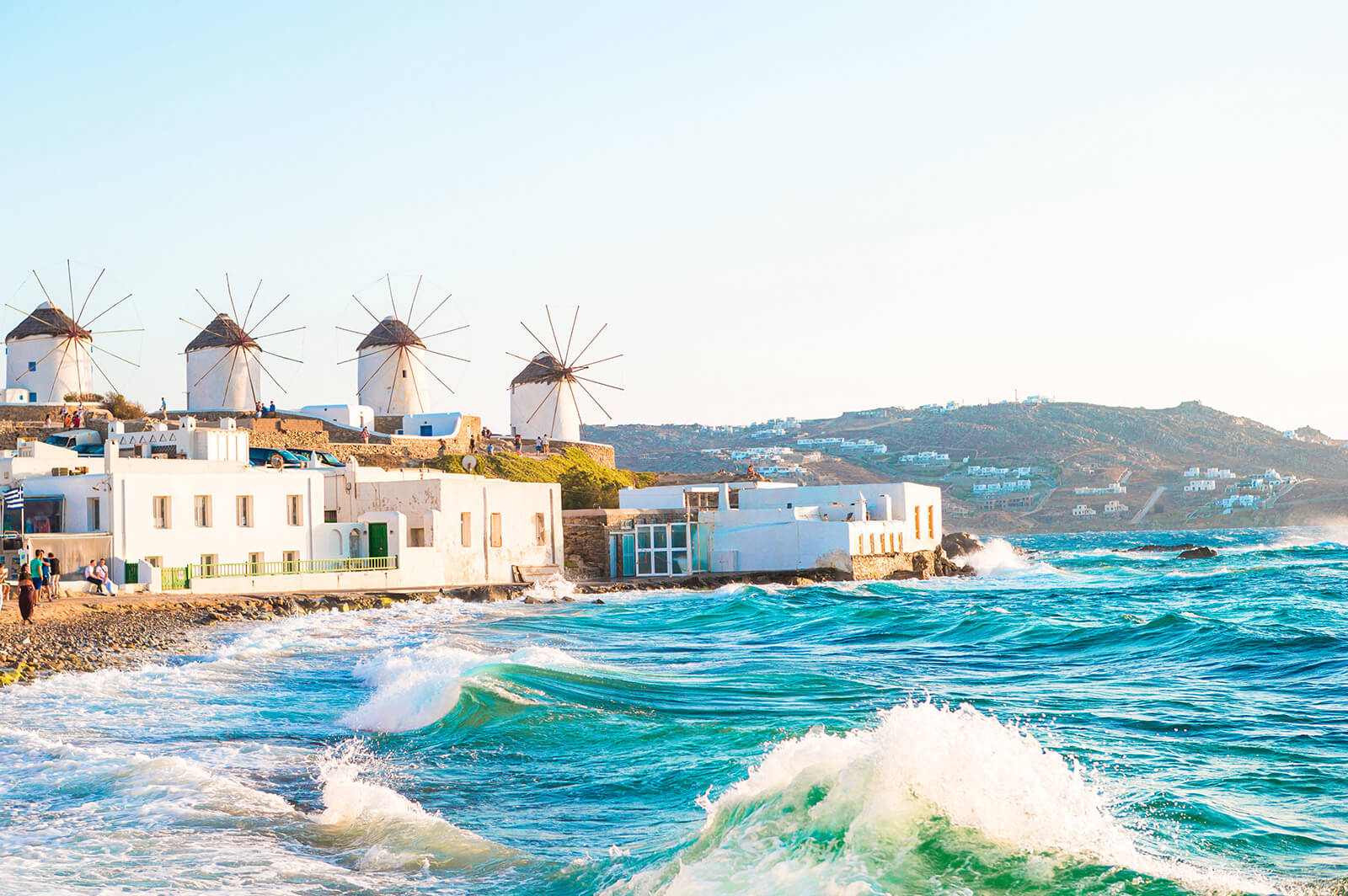
Mykonos is one of the most visited Greek Islands. It is part of the Cyclades group and lies between Tinos, Syros, Paros and Naxos. The island spans an area of 85.5 square kilometers (33.0 sq mi) and rises to an elevation of 341 meters (1,119 feet) at its highest point. Mykonos is so incredibly beautiful; it is not surprising that it has become one of the most desired destinations in the world. When you also add the cosmopolitan lifestyle, the sophisticated nightlife and the historical treasures of the nearby UNESCO Awarded Delos you’ll have the recipe for an unforgettable holiday. SeaDream usually anchors just of the famous windmills and tenders directly to the old town. Guests have a few organized options including the Sacred Island of Delos. Others may simply want to explore the island’s incredible beaches, boutiques, clubs and churches independently.
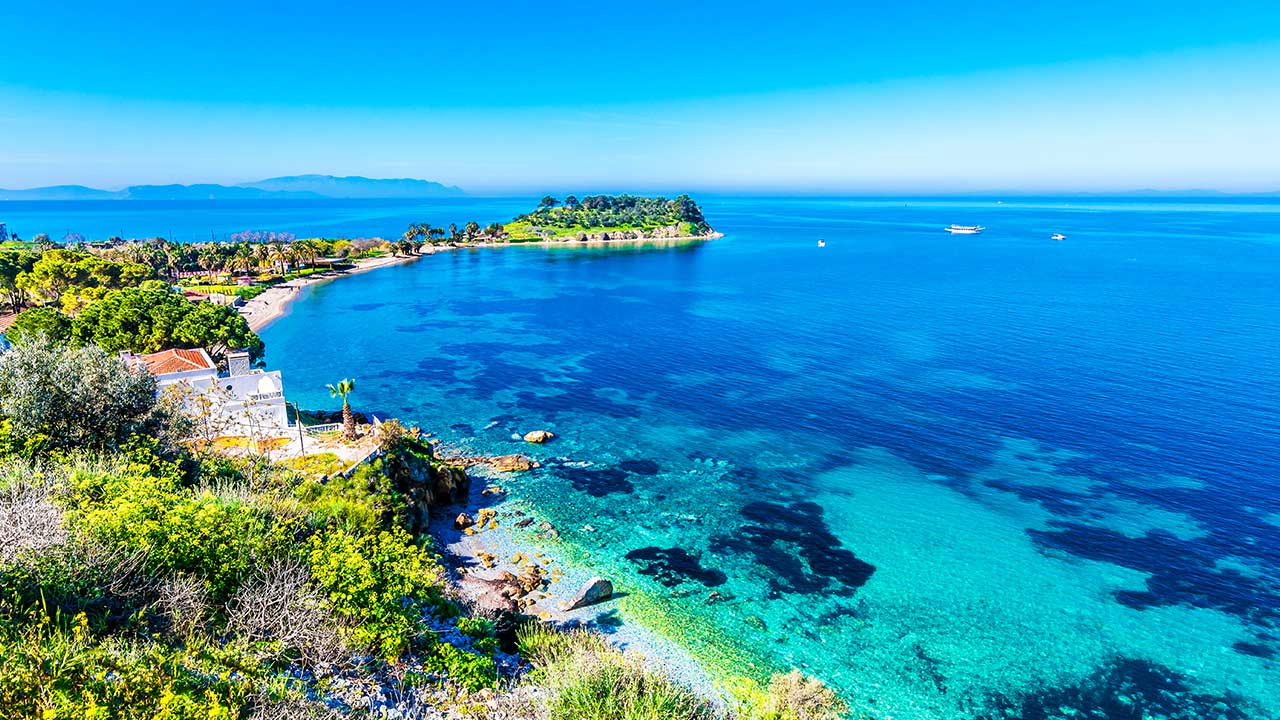
Kusadasi is a beach resort town on Turkey’s Aegean coast and the center of the seaside district of the same name in Aydin Province. The seaside town is also your gateway to the classical ruins at nearby Ephesus, among the world’s best preserved ancient Greco-Roman remains, including its excavated Terrace Houses and House of the Virgin Mary. Kusadasi’s seafront promenade, marina, and harbor are lined with quaint restaurants. Just offshore on Pigeon Island stands a walled thirteenth-century Byzantine castle that once guarded the town. Meet resident wild boars at nearby Dikek National Park, comprised of four secluded beaches, a spectacular coastline, and incomparable views of the Aegean Sea, just one of Turkey’s many protected conservation areas.
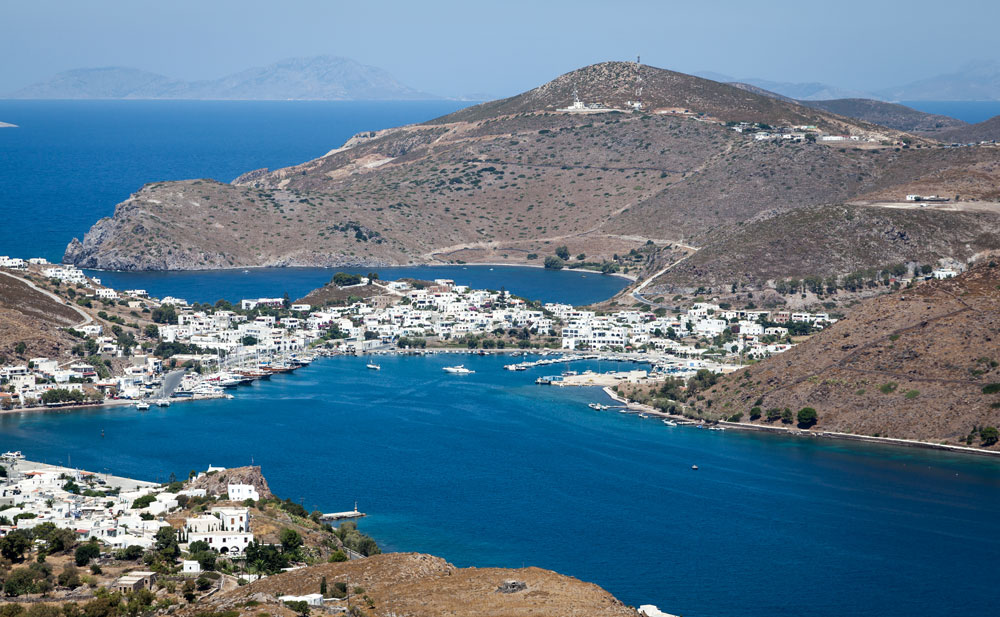
Patmos is in the South Aegean Islands, particularly a member of the Dodecanese Islands of Greece. It is north of Leros and is most known for its connection to John the Apostle from the Book of Revelations; therefore Christian pilgrims frequent this destination. In mythology, Patmos was named “Letois”, which is another named for the goddess Diana, Leto’s daughter. Since ancient authors seldom mention Patmos in early text, information on early inhabitants is limited. It is widely believed the original people of Patmos were the Carians from Asia Minor, as discovered by the earliest archaeological findings date back to the Bronze and Mycenaean periods. The mountain in the country of Caria was named Latmos, which is where historians believe the name Patmos is derived from. Dorians also colonized in Patmos, and over time, Ionians followed suit. The primary port in Patmos is Skala, which was one of the most important sea ports in the Mediterranean around the 16th century. Early Christian basilicas were constructed in the name of John of Patmos, however between the 7th and 9th century when Saracen attacks were still problematic, the Grand Royal Basilica was destroyed. A monastery began construction in 1101 when Christodoulos assumed authority over Patmos. The population began expanding as immigrants from the fall of Constantinople and Candia to place in the 15th and 17th centuries, respectively. The island was under the Ottoman rule for years and was interrupted by Venice during the Candian War, Russia during the Orlov Revolt, and Greece during their War of Independence. During the Italo-Turkish War, Italy occupied Patmos until 1943, when Nazi Germany held power over the island until 1945. Since Patmos rejoined in 1948, it has become the tranquil and frequented destination it is now. Tourists visit the Monastery of St. John, Chora, the Cave of Apocalypse, Psili Ammos Beach and other beautiful points of interest in “Europe’s most idyllic place to live,” as named by Forbes in 2009.
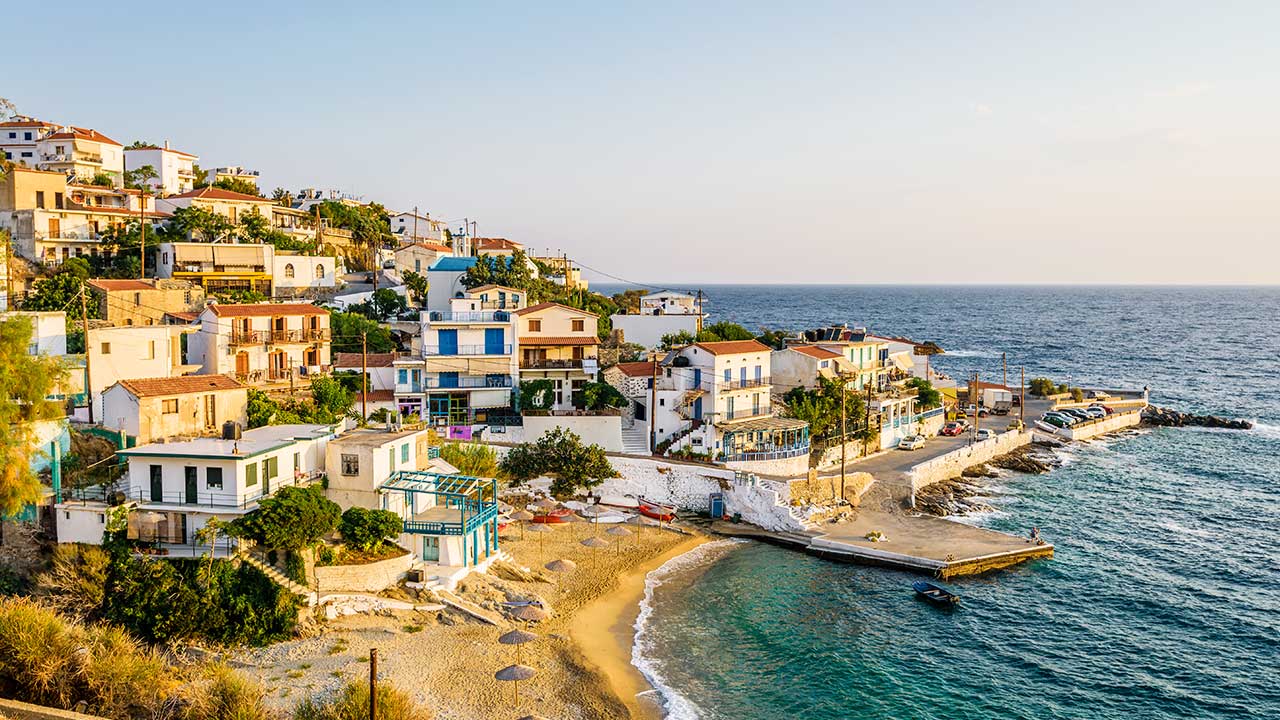
Nestled in the eastern Aegean Sea, the remote island of Ikaria is best known as one of the world’s five “Blue Zones,” regions where locals enjoy good health and live longer than the average person. Learn the secrets to longevity from the Ikarians’ culture and lifestyle, which they say is the result of consuming strong red wine, late-night domino games, and a relaxed lifestyle. Often recognized as the best Greek island for nature lovers, Ikaria features a stunning coastline with pristine beaches and abundant nature. There are over 200 villages scattered throughout Ikaria, giving the island its authentic character.
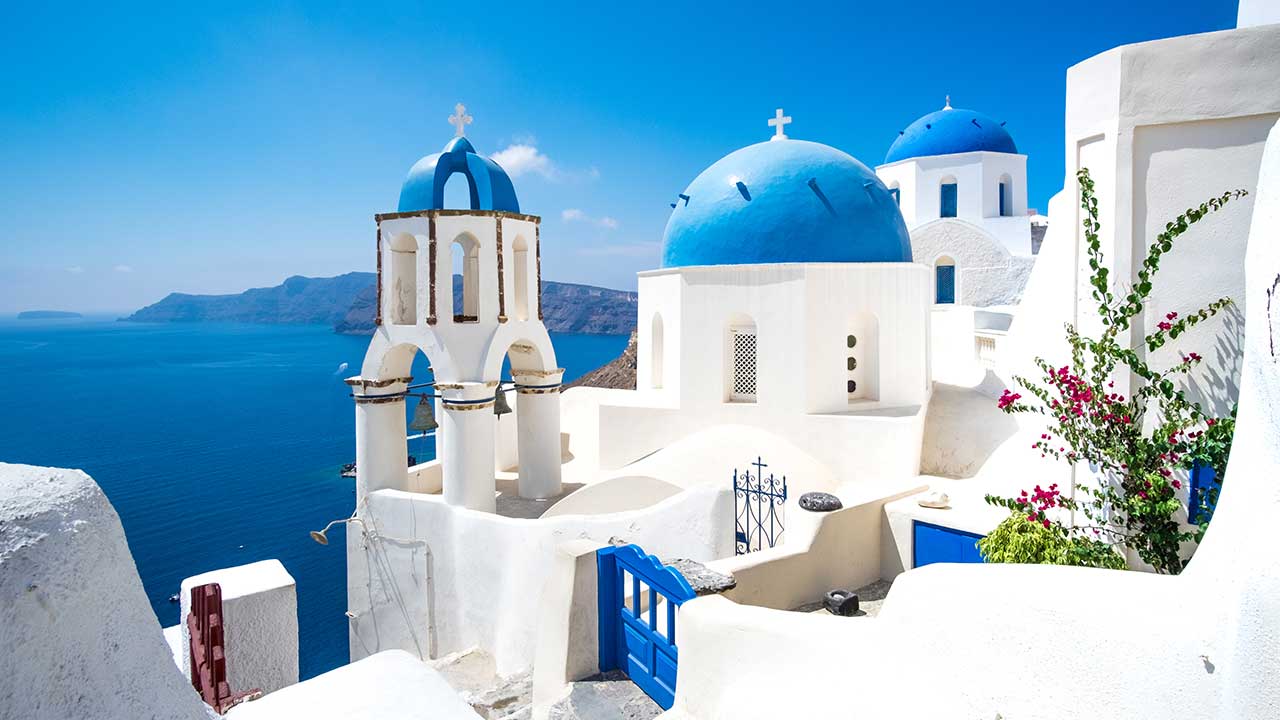
Santorini, officially named Thira, is the southernmost Greek island that is within the Cyclades archipelago, in the southern Aegean Sea. Part of the regional unit Thira, the municipality of Santorini is comprised of the island Santorini, Therasia, and other uninhabited islands of Christiana, Palaia Kameni, Aspronisi, and Nea Kameni. The geological history of Santorini is quite complex due to the area’s volcanism and is currently a water-filled caldera: a rectangular lagoon that is surrounded by three steep cliffs. The name Santorini is a contraction of the name Santa Irini, which is based on an ancient cathedral found in the island’s village of Perissa. This name was given by the Latin Empire in the 13th Century. During the Ottoman Empire, Santorini was called “Santurin” or “Santoron”, and in early times, it was named Kalliste, Strongyle, and Thera. Santorini is the site of the Minoan Eruption (also known as the Thera Eruption), one of the largest eruptions ever in recorded history. The origins of Plato’s story of Atlantis is believed to have a connection to this eruption that destroyed the early settlements on what was formerly a single island. The descriptions found of Plato’s Atlantis strongly resembles Thera, and with seismological, archaeological, and volcanological evidence, these claims are further supported. There is also speculation that the eruption is related to the Exodus of the Israelites, as well as causing the plagues described in the Bible in ancient Egypt. The economy is sustained by two principal industries: tourism and agriculture, and has recently been voted as one of the world’s most beautiful islands in various outlets such as the Traveler’s Choice Awards in 2015. The wine industry in Santorini is becoming more relevant as well, made up of Assyrtiko, Athiri and Aidani grape varieties, which is best exemplified in Vinsanto (“holy wine”) which contains all three Aegean varietals. Although Santorini is highly arid, it’s unique ecology and climate allows it to grow unique and prized produce, such as cherry tomatoes, Lathyrus clymenum (a legume), and capers. Thus, tourists indulge in local specialties such as Brantada, Fava, and the traditional dish Santorinio Sfougato.
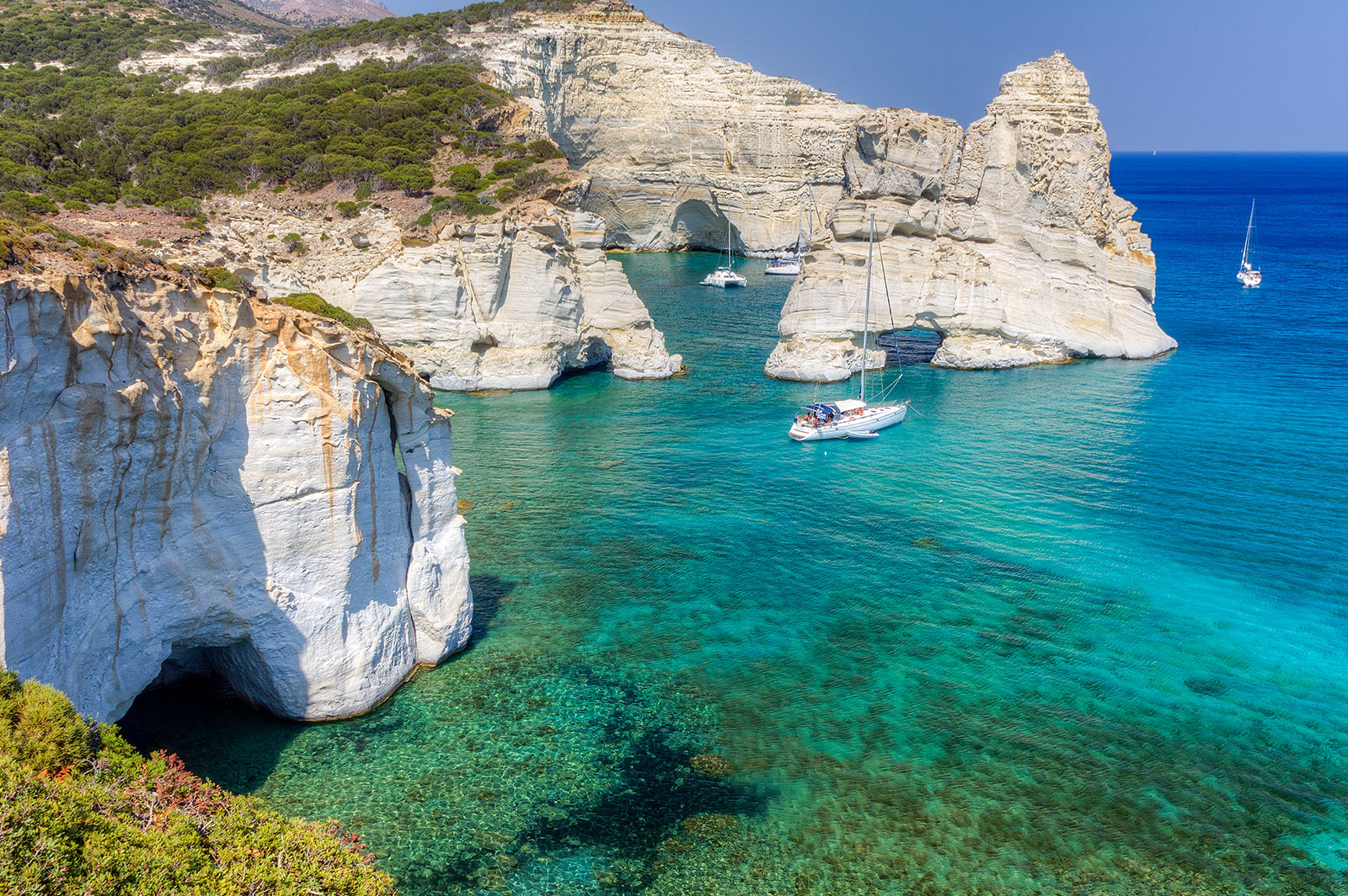
Perhaps providing the most diverse and dramatic coastline of all the Greek islands, sheltered, horseshoe-shaped Milos boasts more than 70 beaches and is heralded as the location where Venus de Milo (the ancient Greek goddess Aphrodite) was discovered. Milos has been named “the island of colors” thanks to its volcanic origin, which offers beaches and waters with a variety of colors and distinct beauty. Due to the volcanic origin of its ground, Milos presents an impressive coastal morphology and diversity. There are white-yellow beaches, bays with pebbles surrounded by stones, and white, red, yellow or black rocks. While discovering your favorite sand upon which to relax, don’t overlook Sarakiniko’s volcanic white cliffs and Papafragas’s emerald-green swimming holes and caves—shaped by the island’s unique minerals, including obsidian, barite, and sulphur, which happily bubble up in abundant hot springs.
Suites & Staterooms
*Single Supplement for this voyage is 200% for Yacht Club Deck 2, 3 and 4. For Commodore, Admiral and Owners Suite, a 200% single supplement rate applies.
Government, Port, Document Issuance, Handling & Service fees: $420 per guest (included)
Please Note: Fares are capacity controlled and may change without notice. The fares are per person based on double occupancy. Single and third person rates are also available. SeaDream Yacht Club strongly recommends that all guests purchase travel insurance.
Yachting Land Adventures & Activities
-
Athens (Piraeus) - Private Transfer - SIXT ride
Description
For seamless ground transportation to or from your SeaDream Yacht, we’ve partnered with SIXT ride to offer premium pre-arranged transfers. Whether you require an airport pickup, private chauffeur service, or on-demand transport, SIXT ride provides a variety of high-quality vehicle options with professional drivers, transparent pricing, and cashless convenience.
Notes
To arrange your transfer, please visit https://www.sixt.com/ride/partners/seadream
Duration
hour(s)
Price
(USD)
-
Mykonos - A Relaxing Day at the Beach
Description
Swim, relax and enjoy the beach facilities at one of the most beautiful and sandy beaches of Mykonos Island – Elia beach.
Mykonos is known for its golden sandy beaches and crystal clear waters. Take this opportunity to enjoy some time at one of the famous beaches of the island, the sandy beach of Elia where necessary changing facilities, beach chairs and umbrellas are available. The beach of Elia is fully organized offering also a wide choice of water sports facilities.Notes
Sunscreen and hats recommended.
A minimum participation is required to operate all Yachting Land Adventures and some have limited capacity. All adventures in the SeaDream Yachting Land Adventures program are subject to change. Final departure time will be announced on board.Duration
4 hour(s)
Price
149 (USD)
-
Mykonos - The Sacred Island of Delos
Description
This Yachting Land Adventure arrives at Delos Island by a boat from Mykonos. Delos is the island of lights and the mythical birthplace of the God Apollo. Admire the interesting monument of the Agora, the treasures of the various cities, the theatre and the Sanctuary of Apollo.
Not far from Mykonos lies UNESCO listed Delos, the island of light, the mythical birthplace of the God Apollo and the Goddess Artemis. Its name means “that which appears" and, according to mythology, the island appeared amid the waves so that Leto would have a place to give birth to Apollo and Artemis. Delos Island, an area of only five sq. km (almost 2 sq. miles), was once a very important religious, cultural and commercial center. Today, the island is a piece of land covered with archaeological sites: fallen columns, sections of the famous mosaics which adorned the houses of the rich, a stadium, and tiers of seats from a theatre. Among these ruins, five marble lions in a row still stand. These were the guardians of the sacred lake, still gazing out to the east waiting for the sun to rise.
Other interesting monuments, spread over a wide area, are: the Agora, the treasuries of the various cities, the Sanctuary of Apollo, the Theatre, the Sanctuary of the Foreign Gods and the Sacred Mt Cynthus. Leaving the sacred island of Delos you re-board your local boat for the 45-minute return to Mykonos town.Notes
This land adventure operates from Mykonos only if the yacht does not call at Delos on the same itinerary. This visit includes a two-hour walk across uneven surfaces at the archaeological sites so please wear comfortable walking shoes. The departure time will be adjusted according to the departure time of the local boat schedule from Mykonos to Delos. There is very limited shade at the site so bring protection from the sun. There is a coffee kiosk on the island as well as restrooms near the pier on Delos. A minimum participation is required to operate all Yachting Land Adventures and some have limited capacity. All adventures in the SeaDream Yachting Land Adventures program are subject to change. Departures times will be published onboard
Duration
3,5 hour(s)
Price
139 (USD)
-
Kusadasi (Ephesus) - Ephesus & the Elite's Terraced Houses
Description
Uncover the UNESCO World Heritage site, Ephesus, on this guided private excursion that also features a visit to the affluent homes at the famous Terrace Houses.
Meet your guide and depart the pier for a scenic drive to the ancient city of Ephesus, one of the largest and most important cities in the ancient Mediterranean world. Second only to Constantinople, it is estimated that roughly 15% of the total city has been excavated. Situated on the western coast of Asia Minor (modern day Turkey), it was one of the oldest Greek settlements on the Aegean Sea and later became the provincial seat of the Roman government in Asia.
Your guided walking tour will start at the upper gate of Ephesus, as you explore the unending monuments including the Forum, the Odeon, the Library of Celsus, Hadrian’s Temple, the Thermal Baths of Scolastika and the Great Theater, built in the Greek era and reconstructed in the Roman period.
You also visit the spectacular Terrace Houses (villas) located on the side of the hill within Ephesus. They have a fantastic view of the entire city of Ephesus. The Ephesus Terrace Houses reveal how wealthy Romans lived during the city’s glory days. Glass floors let you admire geometric mosaics and still-colorful frescoes gleaming on the walls. The Terrace Houses were discovered by a team of Austrian archeologists during excavations in the 1980’s. Along with the ruins in Pompeii, they constitute some of the most vivid examples of Roman domestic architecture to survive today. Reflect on the lives in the city and homes of Ephesus as you return by coach to your yacht in Kusadasi.Notes
This excursion involves extensive walking and stair climbing at the Terrace Houses, comfortable shoes with non-slip soles are recommended. At Terrace Houses, guests will walk on glass-covered platforms. A minimum participation is required to operate all Yachting Land Adventures, and some may have limited capacity. All adventures in the SeaDream Yachting Land Adventures program are subject to change. Final departure times will be published on-board. Order of sights visited may vary to avoid congestion.
Duration
3 hour(s)
Price
189.00 (USD)
-
Patmos - A Photographic View of Patmos
Description
Take the opportunity to capture unique images of Patmos Island and its daily life with your camera.
This tour, covering the south side of the island, not only gives you the opportunity of discovering hidden places but also an opportunity to photograph the most amazing land and seascapes along with developing your creative eye, composing images from geometric form and abstract pattern.
The tour commences from the Port of Skala by minibus to the old village of Chora, the island’s capital, and a photographer’s paradise! The first experience is a wonderful panoramic view over the island. With a turn or your head, you get a glimpse of the 11th century monastery built like a fort, standing with proud dominance. Your guide takes you through Chora’s labyrinth of winding cobbled streets and maze of arched alleyways which offer a feast of photographic inspiration. Observe the settlement of houses dating from the fifteen hundreds with their white-washed walls, reflecting the light, casting shadows and creating geometric patterns. The alleys, arches and doorways display a harmonious balance revealing subtle architectural details which, through your lens, can become exciting atmospheric images trapped in time.
Next, make your way descending to Diakofti stopping off to photograph the view of the mystical rock of Petra and then on to a boatyard. Here you will have the opportunity to photograph the local islanders at work and the streamline shapes of vessels in dry dock. You will also have the chance to enjoy a refreshment at a local café. Fulfilled with great images and pictures in your photo camera you will return to Skala port.Notes
Be sure to wear comfortable walking shoes, as there is extended walking over uneven surfaces and through narrow streets on this excursion. A minimum participation is required to operate all Yachting Land Adventures and some have limited capacity. All adventures in the SeaDream Yachting Land Adventures program are subject to change. Final departure time will be announced on board
Duration
3.5 hour(s)
Price
189 (USD)
-
Patmos - The Monastery of St. John & Patmian House
Description
Explore the UNESCO-listed Monastery of St. John the Theologian, the divine Grotto, and experience a glimpse of a traditional Patmian home.
Patmos is often called the Jerusalem of the Aegean, the sacred island where St. John wrote the Book of Revelations in the Bible. Depart from the pier today for a short scenic ride to Chora and the UNESCO-listed Monastery of St. John the Theologian, built high on an ancient acropolis. The monastery's massive 15th-century walls and 17th-century battlements loom over the town belying an intimate and peaceful interior of arches, inlaid pebble stone floors, and whitewashed buildings. The charming chapel of Christodoulos is profusely decorated with frescoes and the old treasury, now a museum, displays a breathtaking collection of jeweled chalices, crowns, crucifixes, vestments and ancient manuscripts.
Travel on to the Grotto of St. John where the saint heard the voice of God and wrote his revelations. It was here, the most sacred spot on the island, where St. John the Theologian spent 16 months in exile, and this simple cave is now a chapel and place of pilgrimage. Both the Cave and the Monastery have been UNESCO listed in 1999. The iconostases built into the cave depict St. John's visions and the spots where the saint slept, wrote, and heard "a great voice, as of a trumpet."
Back in Chora you will visit one of the traditional Patmian houses, the house of the Simantiris family. The magnificence of Patmian home interiors is stunning. Entering the thick wooden entrance door is like stepping into another dimension, with Venetian style furniture, handicrafts and multi-colored mosaic ceilings dating from the 18th century. After your visit, drive through the town of Chora on the way back to SeaDream in Patmos.Notes
Proper (modest) dress code is required for the monastery and the Grotto. Women should wear skirts covering their knees and blouses covering their shoulders. Men should wear long pants and shirts covering their shoulders. This land adventure includes some uphill walking as well as steps in the upper town of Chora, the local home and at the Grotto. Therefore, flat and comfortable walking shoes are highly recommended.
A minimum participation is required to operate all Yachting Land Adventures and some have limited capacity. All adventures in the SeaDream Yachting Land Adventures program are subject to change. Departures times will be published onboard.Duration
3.5 hours hour(s)
Price
149 (USD)
-
Ikaria - Blue Zone Healthy Living & Ikarian Cooking Lesson (Evdilos Port on Ikaria)
Description
Learn how to prepare and cook organic Ikarian and Greek dishes and gain insights into Ikaria’s secrets to healthy and happy living.
Enjoy a wonderful day of learning, cooking and enjoying delicious Ikarian food & wine, hospitality, friendship and lifestyle. Depart the port for an approximately 20 minutes’ drive, to arrive at a beautiful family winery located in the mountains. The estate belongs to a very well-known Ikarian family, who are internationally renowned for their expertise in Ikarian food/wine and healthy living.
Upon arrival, you will be met by your host and cooking instructor, Eleni, who is a renowned and passionate Ikarian chef and food expert. She has a lifetime's experience in traditional Ikarian cooking and organic gardening and is extraordinarily friendly and gracious. Her husband George is an accomplished wine maker and pioneer in offering winemaking & gastronomy tours/seminars and alternative tourism experiences. Together, the couple have been frequent guests, hosts, commentators, and guides for numerous local and international TV, print and digital media documentaries, news stories and articles about Ikaria and its Blue Zone’s culture and lifestyle health benefits.
Your cooking lesson focuses on learning to prepare traditional healthy Ikarian dishes that are easy to make and that you can adapt to your home country's available products. Among the variety of authentic Ikarian dishes you may learn to cook and then eat are: roasted goat, chickpea and eggplant salads, "Soufiko", a delicious and nourishing vegetable medley which is unique to Ikaria, "pitarakia", traditional Ikarian mini-pies stuffed with fresh from the garden flavored herbs & greens mixes and "Moustalevria", homemade grape wine pudding (the dishes cooked may vary though subject to day’s availability of fresh ingredients). You will then enjoy a delicious meal with all the local delicacies that have been prepared during the cooking lesson. Afterwards reboarding your coach for the return drive to Evdilos and your SeaDream yacht.Notes
Operation of this excursion is from Evdilos port on Ikaria and is subject to weather and sea conditions. This Yachting Land Adventure must be booked 48 Hours (2 days) prior to arrival in the port to confirm its operation during your voyage. Please book on the Seadream.com website, or onboard, early to avoid disappointment. Cancellations after the deadline are non-refundable. To avoid disappointment, we recommend you prebook this adventure prior to starting your cruise. A minimum participation is required to operate all Yachting Land Adventures. All adventures in the SeaDream Yachting Land Adventures program are subject to change. Final departure time will be announced on board.
Duration
4 hour(s)
Price
389 (USD)
-
Ikaria - In the Footsteps of Dionysus (Agios Kirikos Port on Ikaria)
Description
Take an ancient hiking trail crossing the east cape of Ikaria; journeying through the history, archaeology, mythology and mysteries of Ikaria.
Meet your guide pier side and travel by coach approximately 20 minutes to the Fanari Village and start of this ancient hiking trail. The trail crosses important biodiversity areas for marine, animal life and geological formations. During the walk you enjoy hiking on the longest beach of the island crossing from the south to the north coast. Take in the fresh air perfumed with the essential oils of the medicinal plants of the east cape.
Vist one of the best-preserved towers in the Agean, the Drakano tower; with its imposing circular construction dating back to Alexandrian times and located among the remnants of the ancient Acropolis settlement from the 5th century BC. You will follow in the footsteps of the rebel God Dionysus, who was especially known as the god of wine and ecstasy. Visit the Cave of Lero which, according to tradition, is the birthplace of the ancient Greek God Dionysus. Inside the cave you will enjoy a local herbal tea, while you travel back to the ancient times through interpretive mythology storytelling. The walk concludes at the beach of Iero (holy) where you can enjoy swimming in the crystal waters of Ikarian sea. Afterward, reboard the coach for the return drive to Agios Kirikos and your waiting SeaDream yacht.Notes
This is a moderately strenuous hike involving steep inclines along the rocky coastline to gain access down to the beach and cave. Norwegian walking sticks are available for use on this adventure. This hike is not recommended for inexperienced hikers. If you plan to swim, please wear your swimsuit under your clothing and bring a towel as there are no changing facilities available. Sturdy hiking shoes are recommended, not open sandals.
A minimum participation is required to operate all Yachting Land Adventures, and some may have limited capacity. All adventures in the SeaDream Yachting Land Adventures program are subject to change. Final departure times will be published on-board.
Operation of this excursion is from Agios Kirikos port on Ikaria and the arrival is subject to weather and sea conditions. This Yachting Land Adventure must be booked 72 Hours (3 days) prior to arrival in the port to confirm its operation during your voyage. Please book on the Seadream.com website, or onboard, early to avoid disappointment. Cancellations after the deadline are non-refundable.Duration
4.5 hour(s)
Price
229 (USD)
-
Santorini - Akrotiri Archaeological Site & Oia Village
Description
On this land adventure, discover the picturesque village of Oia and one of the most important prehistoric settlements of the Mediterranean: Akrotiri Archaeological site. Could Akrotiri be the lost city of Atlantis?
One of the reasons Santorini has attracted the world’s attention is the excavation at Akrotiri, which reclaimed a whole prehistoric Minoan city from the volcanic ash. The prehistoric site of Akrotiri is on the south-western tip of the island and was discovered in 1967 by Professor Spyros Marinatos. The city was buried by the Theran volcanic eruption in the middle of the second millennium BC.
Over the years, excavations have brought into light a remarkably well-preserved site with two and three-story homes decorated with marvelous wall paintings and frescoes, an advanced drainage system and many interesting objects, artwork, pottery and furniture which give a picture of a society which was very well organized and at the peak of prosperity. This was interrupted suddenly by the eruption of the volcano, which buried the entire city. An ambitious modern bio-climatic roof top structure protects this important archaeological settlement where excavation works are still in progress.
After exploring the excavations with a guide, ride to the northeast part of the island and its most picturesque town, Oia. Built high up on the ridge of red rocks, it offers breathtaking views of the blue Aegean. Take a stroll around the narrow streets with the old beautiful houses and the tiny picturesque shops. Enjoy the breathtaking views of the caldera cliff and wander in the narrow streets for shopping or a cup of coffee during your free time in the village.
The guide visit ends in the town of Fira. Wander along the edge of the caldera for amazing views or wander through narrow streets with the various shops. When ready, take a cable car or walk along the path down to the small port of Skala Fira for tenders back to the SeaDream yacht.Notes
A minimum participation is required to operate all Yachting Land Adventures, some have limited capacity. All adventures in the SeaDream Yachting Land Adventures program are subject to change.
Duration
4 hour(s)
Price
179 (USD)
-
Santorini - Islands of Santorini Caldera by Private Catamaran
Description
Cruise the caldera and its volcano on a private luxury catamaran whilst enjoying the stunning views together with refreshments.
Transfer by tender to the pier in Vilhada where the captain and crew wait for your private catamaran cruise. Enjoy wine, beer, soft drinks, and appetizers on board throughout the sailing.
Take in the sea breezes and beautiful views while sailing past Red Beach, White Beach, the rock formations of Akrotiri and the lighthouse. Coming into view next will be the volcanic islands formed around 1570 BC.
Next, disembark and enjoy the beautiful otherworldly surroundings on the island of Nea Kameni. Take the opportunity to relax on the beach or walk up to the island’s crater and visit the natural hot springs, which have waters that are green and yellow due to their mineral content.
After exploring the village, board the catamaran for a journey back to the old port to tender back to the SeaDream yacht.Notes
A minimum participation is required to operate all Yachting Land Adventures and some have limited capacity. All adventures in the SeaDream Yachting Land Adventures program are subject to change. Final departure time will be announced on board.
Hat, sunscreen and good walking shoes are recommended. If you opt to swim in the natural hot springs; please be advised that the mineral content in the water can stain your clothes.Duration
4 hour(s)
Price
549 (USD)
-
Milos - Discover Milos' Highlights
Description
Explore the impressive highlights of Milos on this concise orientation Yachting Land Adventure.
Your experience starts with a visit to the classic Cycladic village of Plaka, with cobblestone streets and white stone houses accentuated with bougainvillea flowers and located 250 meters above the Aegean Sea. Stroll through the village and admire the traditional architecture with its stunning view of the sea, particularly from the courtyard of the Korfiatissa Church.
From Plaka, reboard your coach for a drive to the idyllic landscape of Papafragas, one of the most impressive sites of Milos. From the top of the rock, it resembles a huge natural swimming pool, and its three caves were used as pirate hideouts during Byzantine times. From the overlook, admire the remnants of the imposing Cyclopean wall of ancient Phylakopi site, one of the most important settlements of the Prehistoric Aegean.
Your next stop will be Sarakiniko, an inlet of pure white stone sculpted by volcanic eruptions. This startling beautiful, out-of-this-world spot is one of the island’s many geological wonders and perhaps one of the most photographed places in the Cyclades. You have the opportunity to walk down to a point where you will encounter this one-of-a-kind beach and take photographs. You will feel as if you have landed on the moon (optional swimming).
Then, reboard the coach for the return drive to the yacht in Milos.Notes
If you desire to swim during the stop at Sarakiniko, please bring your towel from the yacht and wear your swimming clothes under your regular clothes, as there are no changing facilities. Please also return to the bus as dry as possible after swimming since it is not allowed to enter the bus with wet clothes.
A minimum participation is required to operate all Yachting Land Adventures and some have limited capacity. All adventures in the SeaDream Yachting Land Adventures program are subject to change. Final departures times will be announced onboard.Duration
3.45 hour(s)
Price
139 (USD)
-
Milos - Gastronomy of Milos (Full Day)
Description
Take the time to unwind while exploring the traditional local dishes, wine and sites across Milos Island.
Board your vehicle for a scenic drive to the picturesque village of Plaka, which impresses its visitors with its authentic charm and beauty. Here you will have the opportunity to visit an old, refurbished café, where you can indulge in traditional Greek coffee made the real way. Also sample the famous watermelon pie and other homemade delightful, sweet flavors such as the delicious dessert known as “koufeto”. The tradition and method of producing this “spoon sweet” will also be explained.
After admiring the amazing scenery of Plaka and taking memorable photos, you will head to the unique Volcanic Cave Winery, where you will sample the local wine varieties along with delicious products grown on the farm. All within a beautiful and relaxing setting, nestled between the shade of olive trees.
Continuing on, you will be offered an introduction to the authentic local gastronomy of Milos at “Alevromylos”, one of the famous restaurants in Milos. The restaurant’s chef Vassilis will further expand your horizons with an introduction to the history of “Cucina Povera” and the most famous of its products, the “Pitarakia” of Milos.
The last stop will be at the incredible volcanic swimming pool of Papafragas Cave, situated alongside the ruins of one of the most important prehistoric sites of the Aegean Sea. Afterward board the coach for the return drive to the yacht in port.Notes
August is peak season and if the restaurant is not available, then an alternative venue will be provided of similar quality providing a similar experience.
Please bring a towel from the yacht and wear your swimming suit under clothing as there are no changing room facilities. The beaches are rocky and water shoes are recommended.
A minimum participation is required to operate all Yachting Land Adventures and some have limited capacity. All adventures in the SeaDream Yachting Land Adventures program are subject to change. Final departure time will be announced on board.Duration
6.5 hour(s)
Price
399 (USD)
Prices are per person, in USD. Duration is in hours.
Testimonials
At SeaDream, our experience was great in the lap of nature (at sea). The hospitality, courtesy and responsibility was at its height... flowing throughout the voyage. Really a memorable experience!! Mitu & Harjit S.India
This was a wonderful experience thanks largely to the size of the ship and the wonderful staff – they made it memorable. Mr & Mrs BoyleSouth Africa
